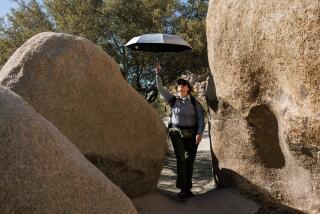Sweating It Out : W. German Students Adjust to Culture Shock of Desert
- Share via
JOSHUA TREE NATIONAL MONUMENT, Calif. — “Ooh! Ooh! Ooh!” yelled Michaela Kratochwil as she retreated from the cactus patch.
“I have never been bitten by a plant in Germany,” sighed the 23-year-old woman as her friend Andrea Seyferth, 27, gingerly pulled a teddy bear cholla cactus spine from Kratochwil’s foot.
The two West German university students are spending the summer working as volunteers at this national monument on the Mojave Desert 155 miles east of Los Angeles.
It was culture shock when they woke up their first morning here June 1. They had flown across the Atlantic and across the United States, arriving in Los Angeles at night. Two National Park Service rangers met them at the airport and drove them here.
They awakened the next day to the hottest temperatures they have ever experienced. It has been that way ever since.
“You know it was 120 the other day,” said Seyferth, wiping the sweat from her brow on this relatively cool 110-degree day. “Everything is different here than in Germany, the heat, the dry mountains, the bushes, trees, flowers, animals, insects. . . .” Kratochwil and Seyferth are landscape architect majors at Fachhochschule Nurtingen, a university near Stuttgart. It is, they say, the second-best landscape architect school in Germany.
“We have a system at the university for our major. We go to school three semesters, then we are volunteers for two semesters, working for free to get practical experience. Everyone usually does their volunteer work in Germany. We decided to spend one of our volunteer semesters here at Joshua Tree,” explained Kratochwil.
They heard of Joshua Tree National Monument through friends who had been here. They thought it would be a great adventure and a unique learning experience to work in the heat of summer on the Southern California desert. So, they wrote to officials at the national monument and asked if two university landscape architect students could spend three months working eight hours a day, five days a week--for free.
“We’d love to have you,” replied Anne Marie La Rosa, 36, without hesitation. La Rosa is a vegetation management specialist for the National Park Service and runs the native plant nursery at Joshua Tree National Monument. “What else could I say? We can always use more help. And they were volunteering to work full time without pay.”
Hearing about the two young women from Germany, Jane and Ron Grunt, owners of nearby 29 Palms Inn, said they would gladly provide them with a room without charge if Seyferth and Kratochwil would each work four hours a week designing a garden for the hotel.
“We love our room and everything about the inn, especially the swimming pool to help cool us off in this unbelievable hot weather,” Seyferth said.
The two women spend a lot of time driving around the 500,000-acre monument in a National Park Service pickup, collecting seeds from native plants and trees to use for propagating plants at the nursery. They each drink nearly five gallons of water on days they spend working outdoors.
“We are working with plants we not only have never seen before, but never even knew existed, plants like ocotillo, cholla, mesquite, Joshua trees. We have seen coyotes, tarantulas, snakes, bighorn sheep, lizards, animals you never encounter in Germany,” Seyferth said.
Her schoolmate talked of the quiet and peace of the desert. Few people visit the monument this time of year. It’s just too hot. Kratochwil mentioned “the wide-open spaces. America U.S.A. is a very big place. Germany is a small country. We don’t have open space, only village after village after village,” she observed.
“I can just imagine what it was like in the old days of the Old West with the cowboys and Indians running around. And human beings living here without coolers or air conditioners. It must have been unbelievable,” said Seyferth.
La Rosa said the two women are a tremendous asset: “They are designing a garden using only native plants for the front of the administration building and a demonstration garden to promote the use of native drought-resistant plants by homeowners in the area.”
At the end of August when the two university students complete their “semester” as volunteers, their boyfriends are flying in from Germany to spend a month with them touring California.
“We will probably have our fill of the desert by then,” Kratochwil said, “and head for the seashore and mountains where it is cool.”
More to Read
Sign up for Essential California
The most important California stories and recommendations in your inbox every morning.
You may occasionally receive promotional content from the Los Angeles Times.










